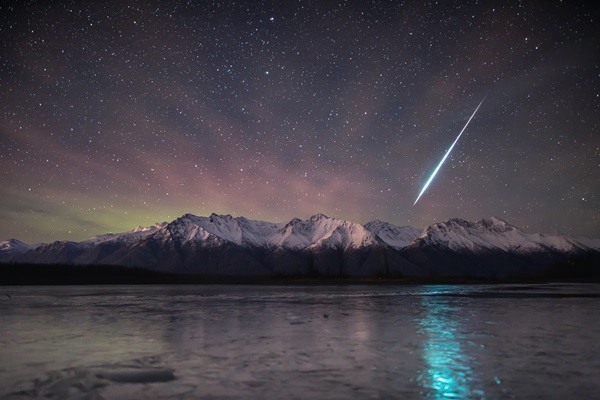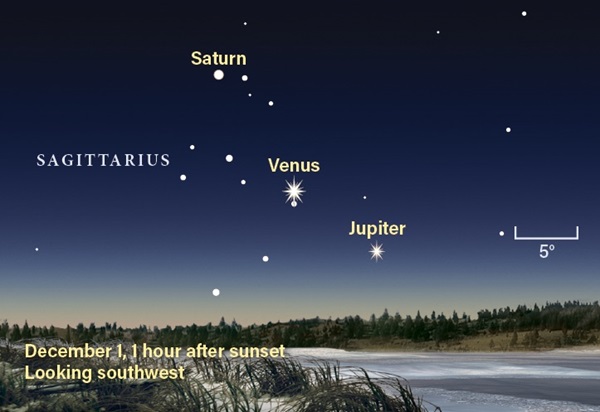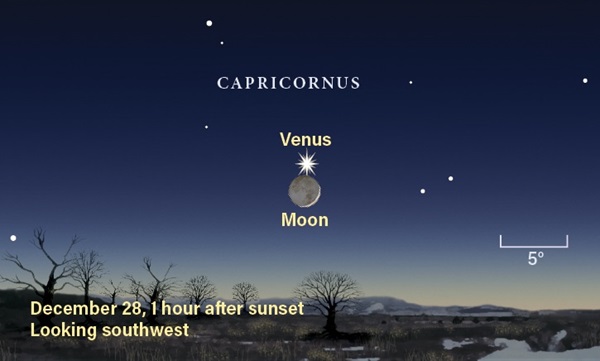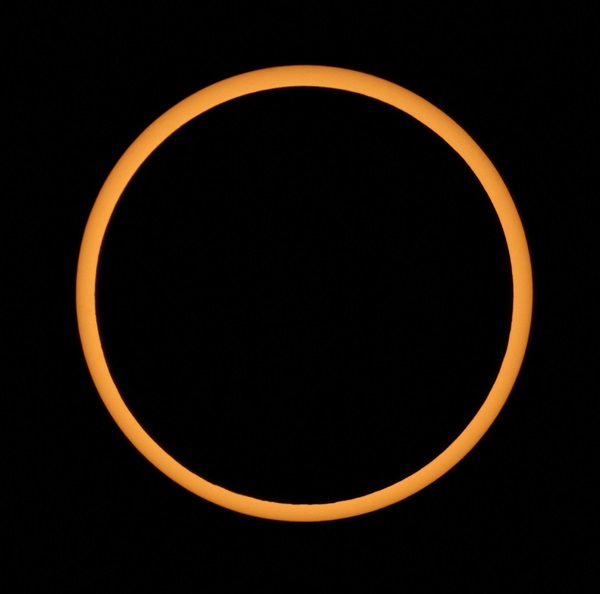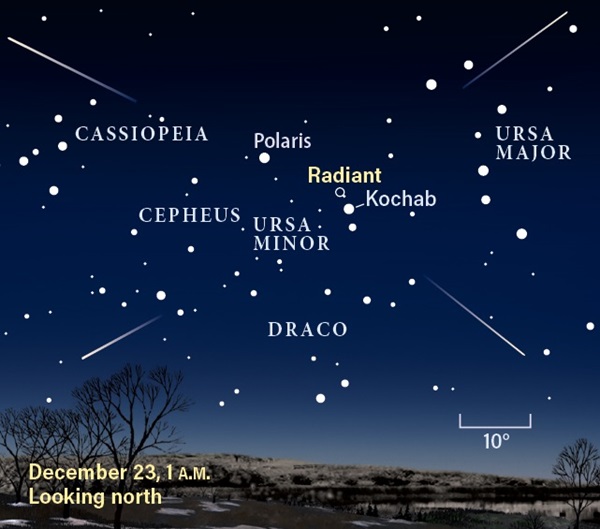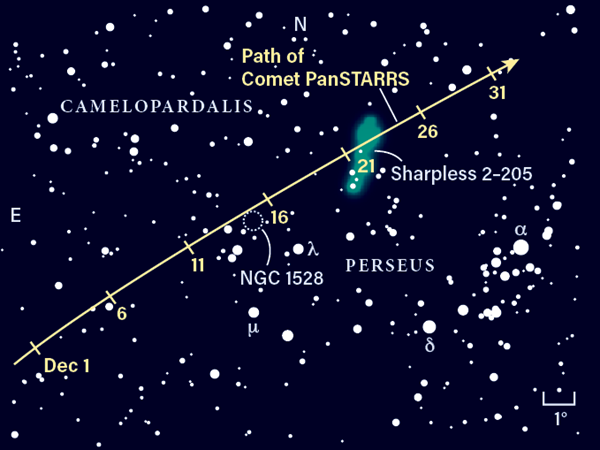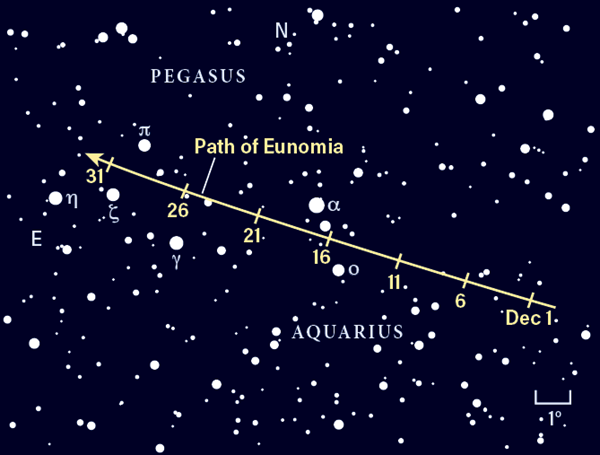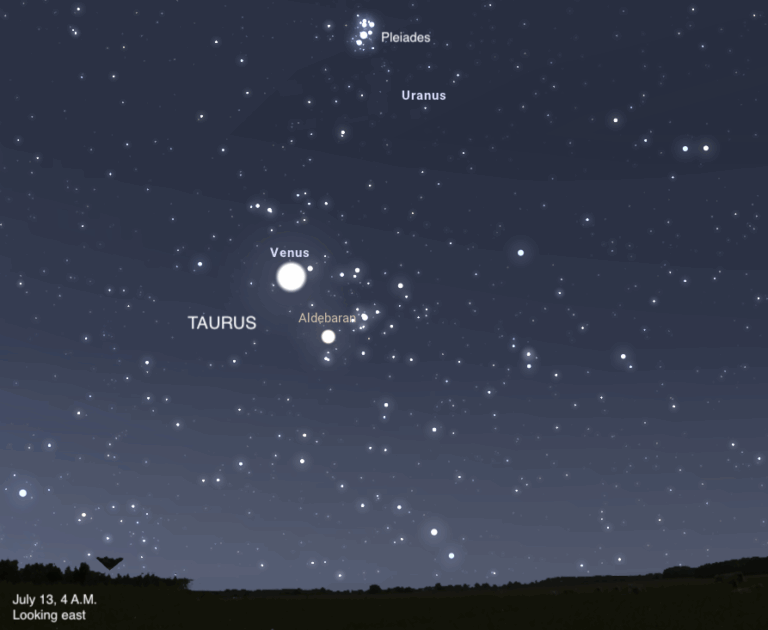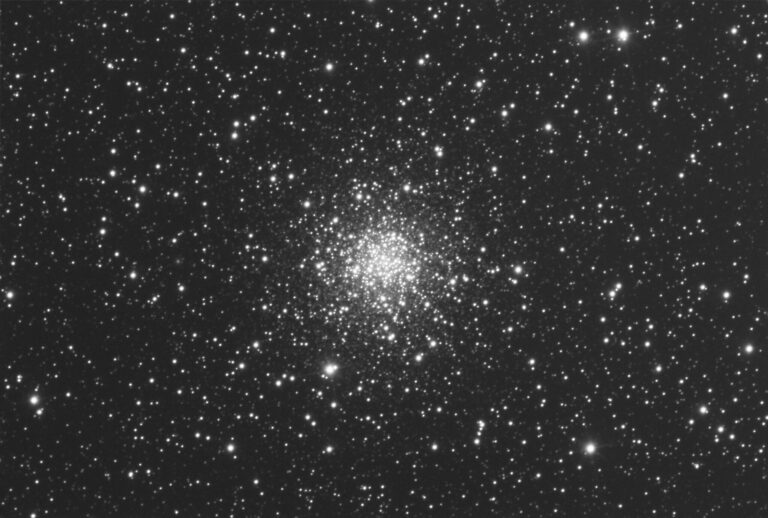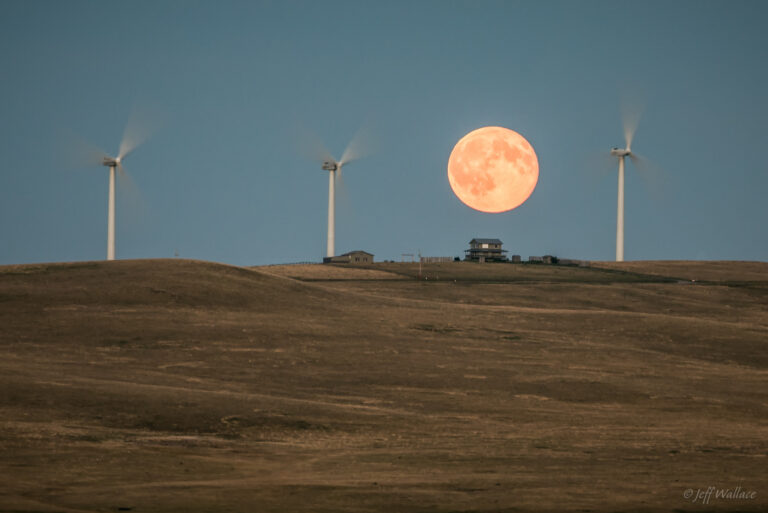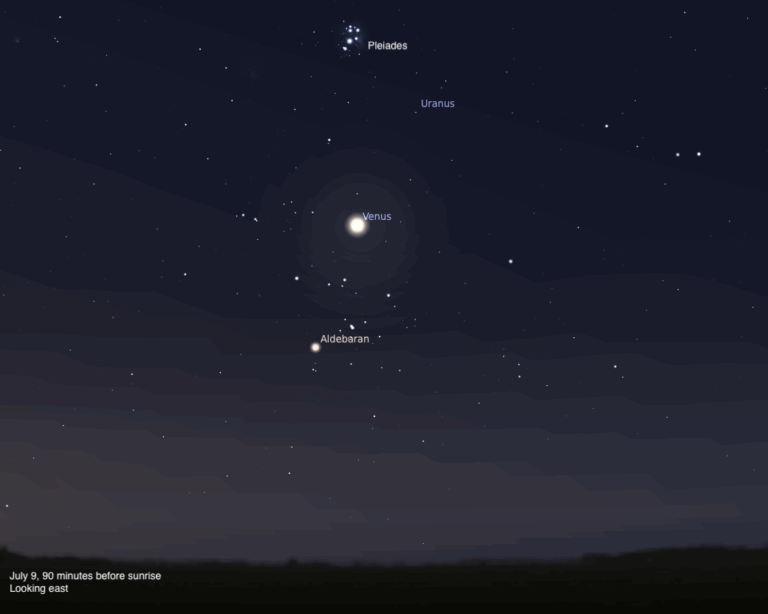Key Takeaways:
December’s highlight has to be the dramatic lineup of planets in the early evening sky. While Venus dominates the view toward the southwest after sunset, Saturn and Jupiter add a lovely flair to the scene early this month. Uranus and Neptune, which appear much fainter than their closer cousins, appear higher in the sky and remain visible through the late evening hours. Eventually, the long nights end with fine views of Mercury and Mars before dawn.
Venus fares far better. On December 1, it shines at magnitude –3.9 — seven times brighter than Jupiter — from a perch 8° to the giant planet’s upper left. You’ll have to wait for the sky to darken some before you’ll be able to see magnitude 0.6 Saturn, which lies 11° to Venus’ upper left.
Target Venus with binoculars December 2 and you’ll see one of the sky’s finest globular clusters, 5th-magnitude M22 in Sagittarius, less than 1° to the north. A telescope shows the planet’s 12″-diameter disk and 88-percent-lit phase.
Each night, Venus climbs a bit higher while Saturn sinks a little lower. The two are destined for a close encounter December 10, when Venus passes 1.8° south of its companion.
Saturn continues to lose altitude after this conjunction and becomes lost in the Sun’s glow before Christmas. Plan to catch your final telescopic views of the ringed world in early December. On the 1st, the planet’s disk measures 15″ across while the rings span 35″ and tilt 24° to our line of sight.
Once Jupiter and Saturn succumb to bright twilight, Venus rules the evening sky. On December 18 and 19, it passes within 1° of the 9th-magnitude globular cluster M75 on Sagittarius’ eastern edge. Venus crosses into Capricornus on the latter date and spends the rest of the month among the Sea Goat’s stars. A slim crescent Moon slides 2° below the planet on the 28th, when the pair remain visible for more than two hours after sundown.
The planet resides in the same binocular field as 4th-magnitude Phi (ϕ) Aquarii. On December 1, Neptune lies 1.5° west-southwest of this star. Look for a 7th-magnitude field star 0.9° due west of Phi. The planet forms an isosceles triangle with these two stars.
Neptune moves slowly eastward relative to the starry background during December. By the 31st, it has closed to within 1.1° of Phi. If you have a hard time identifying the planet, target your suspect with a telescope. Only Neptune shows a disk, which appears 2.3″ across and blue-gray in color.
Uranus proves to be an easier target. Not only does this planet shine brighter than Neptune, at magnitude 5.7, but it also appears higher in the sky. Uranus lies in the southeast after darkness falls and climbs 60° above the southern horizon around 9:30 p.m. local time in early December. It reaches the same position two hours earlier by month’s end.
The planet lies in a sparse region of southern Aries, near the Ram’s border with Pisces the Fish. Although it’s bright enough to be an easy target through binoculars, the lack of nearby guide stars makes it tricky to pinpoint.
Start with the Ram’s brightest star: magnitude 2.0 Hamal (Alpha [α] Arietis). Then locate magnitude 3.8 Alrescha (Alpha Piscium) 21° due south of Hamal. If you draw an imaginary line between these two stars, you’ll find Uranus about 1° from the midpoint in the direction of Alrescha.
Although Uranus has about the same physical size as Neptune, it lies 1 billion miles closer to Earth, or a bit less than two-thirds as far away. Do the math, and you’ll find Uranus should appear slightly more than 50 percent larger when viewed through a telescope. It does — Uranus spans 3.7″ this month, and its disk sports a delightful blue-green color.
The gap between these two worlds grows as the month progresses because Mars is pulling away from the Sun while Mercury is drawing closer. You can follow Mercury throughout December’s first half. It rises an hour before the Sun on the 15th, though it stands only 6° high a half-hour later. If you have an exceptionally clear sky and an unobstructed horizon toward the southeast, you might spot the 1st-magnitude star Antares 5° to its lower right.
The best views of Mercury through a telescope come on December’s first few mornings. It then shows a 6″-diameter disk with a gibbous phase. The planet moves away from Earth in the following weeks, shrinking slightly as it waxes toward full.
As Mars moves eastward across Libra, it sets dead aim on the 3rd-magnitude double star Zubenelgenubi (Alpha Libra). On the morning of December 12, the planet stands just 13′ north of this star. View the pair with binoculars or a telescope to see a nice color contrast between Zubenelgenubi’s whitish glow and Mars’ ruddy hue.
You’ll also want to check out the attractive pairing of a waning crescent Moon with Mars on December 22 and 23. The Moon stands 9° above Mars on the 22nd and 6° to the planet’s lower left on the 23rd.
Although Mars offers a visual treat on December mornings, it doesn’t look like much through a telescope. The planet’s 4″-diameter disk shows no detail, and likely won’t for several more months. But things will improve next spring as Mars heads toward an exceptionally good opposition in October 2020.
The Moon has three prominent encounters with solar system objects in December: a conjunction with Mars on the 22nd and 23rd, an even closer pass by Venus on the 28th, and a spectacular meeting with the Sun on the 26th. The final one brings an annular solar eclipse to people along a narrow path that touches parts of Saudi Arabia, Qatar, the United Arab Emirates, and Oman just after sunrise. The track then crosses southern India and northern Sri Lanka in late morning; Sumatra, Singapore, and Borneo near midday; and Guam about an hour before sunset. During an annular eclipse, the Moon appears slightly smaller than the Sun and thus leaves a ring of sunlight visible. Viewers need to practice safe solar-viewing techniques to avoid serious eye damage.
Meteor watch: Will the Bear steal the Twins’ show?
December brings two notable meteor showers. The Geminids — the best annual shower — peak the morning of December 14. Unfortunately, the Full Moon arrives just two days earlier. The waning gibbous Moon on the 14th lies in Gemini, the constellation from which the meteors radiate. Bright moonlight will drastically cut the number of meteors, though observers with a good sky who shield themselves from the Moon might still see up to 20 meteors per hour before dawn.
By the time the Ursids peak the night of December 22/23, the Moon has waned to a thin crescent and no longer interferes. Although the shower typically produces only about 10 meteors per hour, major outbursts occurred in 1945 and 1986 with smaller enhancements reported as recently as 2011 and 2014. Meteor experts predict a surge of up to 30 meteors per hour could happen this year, so it might be worth braving the cold for a look.
Rising Moon: The young Moon’s lonesome sea
On December’s first evening, Mare Crisium (Sea of Crises) dominates our view of the waxing crescent Moon. The oval sea lies slightly north of the lunar equator and is the only fully illuminated mare at this phase.
Just “inland” from Crisium’s northern shore lies the 81-mile-wide crater Cleomedes. Named after a Greek astronomer who historians believe lived in the first century b.c., Cleomedes’ lava-covered floor sports the hint of an off-center central peak and two craters between 6 and 7 miles in diameter. Increase the magnification to see Rima Cleomedes, a long, thin rille (channel) that cuts across the main crater’s northern half. Be patient for moments of good seeing, when Earth’s atmosphere steadies. These smaller features disappear under the higher Sun that comes the following few evenings.
You might be just as captivated watching the Sun set over this terrain in the evenings after December 12’s Full Moon. The reversed lighting practically turns this into undiscovered country.
The Moon cycles through a complete set of phases every 29.5 days, so it returns to a waxing crescent in the evenings leading up to New Year’s. On December 28, the same evening Luna appears 2° below brilliant Venus, both Mare Crisium and Cleomedes are half-lit.
When the Moon appears as a slender crescent, earthshine illuminates its “dark side.” It’s a good time to pick out features normally associated with the Full Moon. Look for Tycho’s rays, the bright crater Aristarchus, the debris aprons surrounding Copernicus and Kepler, and the darker seas.
Comet search: A visitor receives a Hero’s welcome
Comet PANSTARRS (C/2017 T2) strikes two notable poses in December as it continues its nine-month tour of the polar sky. Researchers discovered this comet as a 20th-magnitude fuzzball in October 2017 while surveying the sky with the Pan-STARRS1 Telescope on Haleakala in Hawaii. Astronomers expect it to glow at 9th or 10th magnitude this month.
PanSTARRS spends most of December among the background stars of Perseus the Hero, a region that passes nearly overhead during the evening hours. If you have clear skies, haul out a 4-inch or larger telescope on the 14th or 15th and target the star cluster NGC 1528. C/2017 T2 shares a low-power field of view with the cluster both evenings. You’ll need to boost the magnification quite a bit to see detail in the compact but high-surface-brightness comet.
The second photo opportunity comes the weekend of December 21 and 22. The comet then appears to drift across the face of the sprawling emission nebula Sharpless 2–205. Think of the nebula as a fainter sibling to the more famous Heart and Soul nebulae in Cassiopeia. PanSTARRS will pass near that pair in January.
The comet remains on the inbound leg of its elongated orbit around the Sun. Astronomers expect it to reach 7th or 8th magnitude at its closest approach in May 2020.
Asteroid 15 Eunomia splashes across the starry backdrop of Aquarius the Water-bearer in December. Eunomia spends the month within a binocular field of Alpha (α) Aquarii, a magnitude 2.9 star that lies about 20° southwest of the southwestern corner of the Great Square of Pegasus. The asteroid glows at 10th magnitude, however, so you’ll need a small telescope to pick it up.
Eunomia slides 0.8° south of Alpha on the 17th. But the asteroid saves its best encounters for 2019’s final week. It then passes through the Water Jar asterism, a group of 4th- and 5th-magnitude stars comprising Gamma (γ), Pi (π), Zeta (ζ), and Eta (η) Aqr.
To find Eunomia, use the finder chart below to zero in on its approximate location and then sketch the half-dozen or so brightest stars you see through your telescope. Come back a night or two later, and the “star” that has shifted position is the asteroid.
Italian astronomer Annibale de Gasparis discovered Eunomia in 1851. With an average diameter of about 165 miles, it ranks among the dozen biggest objects in the asteroid belt. Scientists suspect it is the remnant of a larger body destroyed in a collision.

